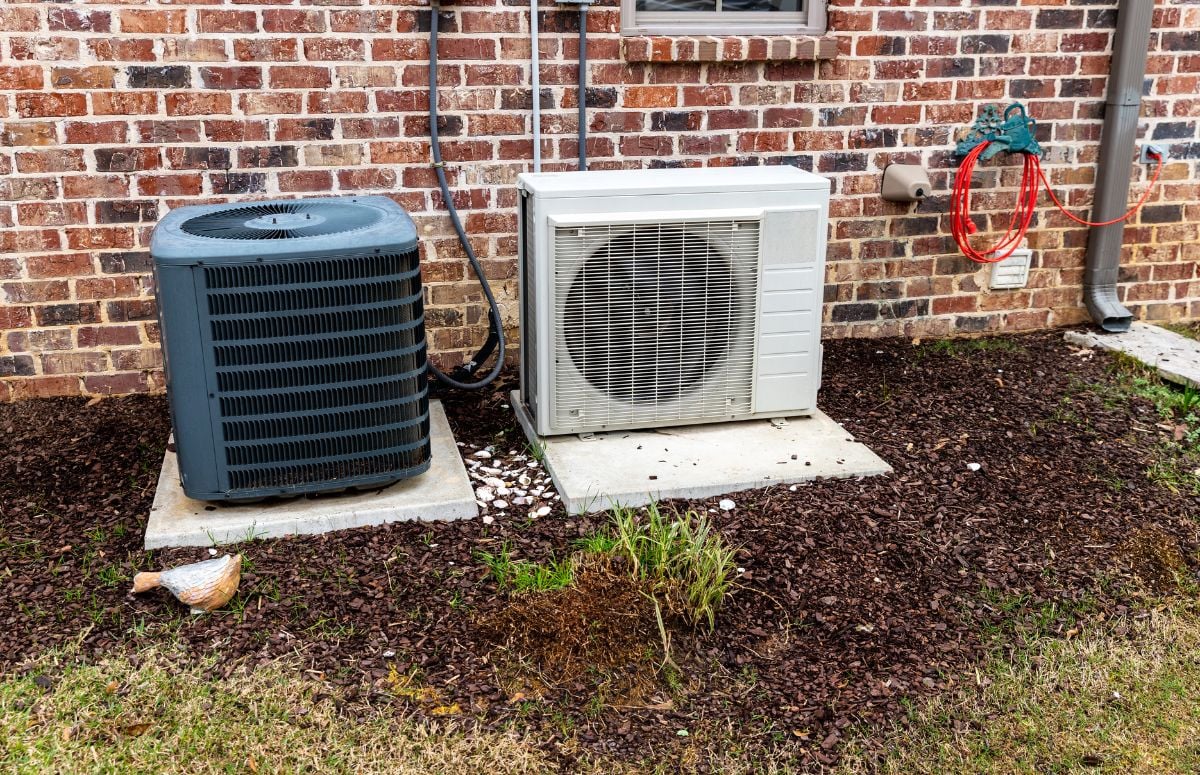If you are looking for a way to keep your home comfortable all year round, you might be wondering whether to choose a mini split or a central air system. Both options have their advantages and disadvantages, depending on your needs, preferences, and budget. In this article, we will compare the features, costs, and installation of mini split and central air systems, so you can make an informed decision.
What are Mini Split and Central Air Systems?
A mini split system is a type of ductless air conditioning that consists of an outdoor unit and one or more indoor units that are mounted on the wall or ceiling. The indoor and outdoor units are connected by a thin conduit that carries the refrigerant, power cable, and condensate drain. A mini split system can provide both cooling and heating by using a heat pump technology.
A central air system is a type of ducted air conditioning that uses ducts to distribute cooled or heated air throughout the house. A central air system consists of an outdoor unit and an indoor unit that are usually located in the attic or basement. The outdoor unit contains the compressor and condenser, while the indoor unit contains the evaporator coil and blower. A central air system can also provide both cooling and heating by using a furnace or a heat pump.
What are the Features of Mini Split and Central Air Systems?
Mini split and central air systems have different features that you should consider before choosing one for your home. Here are some of the main factors to compare:
Efficiency
Mini split systems are generally more efficient than central air systems because they do not have ducts that can leak or lose energy. According to the U.S. Department of Energy, duct losses can account for more than 30% of energy consumption for space conditioning. Mini split systems also allow you to control the temperature in each zone or room individually, which can save energy by avoiding overcooling or overheating areas that are not in use.
Central air systems are less efficient than mini split systems because they have ducts that can leak or lose energy. However, central air systems can still be energy-efficient if they have proper insulation, sealing, and maintenance of the ductwork. Central air systems also have a single thermostat that controls the temperature for the whole house, which can waste energy by cooling or heating areas that are not in use.
Comfort
Mini split systems have higher comfort than central air systems because they allow you to control the temperature in each zone or room individually, which can provide more personalized and consistent cooling or heating. Mini split systems also have less noise and air pollution than central air systems because they do not have ducts that can transmit sounds or contaminants.
Central air systems have lower comfort than mini split systems because they have a single thermostat that controls the temperature for the whole house, which can result in uneven or inadequate cooling or heating. Central air systems also have more noise and air pollution than mini split systems because they have ducts that can transmit sounds or contaminants.
Aesthetics
Mini split systems have lower aesthetics than central air systems because they have visible indoor units that can be unsightly or intrusive. Mini split systems also require a small hole in the wall or ceiling to connect the indoor and outdoor units, which can be noticeable or unappealing.
Central air systems have higher aesthetics than mini split systems because they have hidden indoor units that are not visible or intrusive. Central air systems only require a large outdoor unit that can be placed away from the house or camouflaged with landscaping.
What are the Costs of Mini Split and Central Air Systems?
Mini split and central air systems have different costs that you should consider before choosing one for your home. Here are some of the main factors to compare:
Installation Cost
Mini split systems are more expensive to install than central air systems because they require more labor and materials. According to HomeAdvisor, the average cost of installing a mini split system ranges from $2,000 to $14,500, depending on the number of zones, the size of the units, and the complexity of the installation. However, mini split systems do not require ductwork installation, which can be more expensive than installing a mini split system if your home does not already have ducts.
HomeAdvisor is giving some not so accurate information there, in the real world mini split installs are going for about 4k per head with a minimum of around 7k to get one installed. So for a 6 head system you are looking at north of 24k.
Central air systems are less expensive to install than mini split systems because they require less labor and materials. According to HomeAdvisor, the average cost of installing a central air system ranges from $3,778 to $7,427, depending on the size and efficiency of the unit and the complexity of the installation. However, central air systems require ductwork installation, which can be more expensive than installing a central air system if your home does not already have ducts.
Again that price from home advisor, are they having their brother-in-law install them? Average central ducted systems if you already have ducts is anywhere from $4800-38K, add more if you don’t have ducts.
Maintenance Cost
Mini split systems have higher maintenance costs than central air systems because they have more parts that can break down or wear out. Mini split systems require regular cleaning of the filters and annual inspection by a professional technician. Mold can become an issue if the units are set to cycle between hot/cold as the drain pan for condensate is located very close to the blower wheel.
Central air systems have lower maintenance costs than mini split systems because they have less parts that can break down or wear out. Central air systems require regular cleaning of the filters, ducts, coils, and blower, as well as annual inspection by a professional technician.
Operating Cost
Mini split systems have lower operating costs than central air systems because they are more efficient and use less energy. According to the U.S. Department of Energy, mini split systems can save up to 30% on heating and cooling costs compared to conventional systems. Mini split systems also have lower electricity demand charges because they do not have a large compressor that draws a lot of power at once.
Central air systems have higher operating costs than mini split systems because they are less efficient and use more energy. According to the U.S. Department of Energy, central air systems can cost up to 40% more on heating and cooling costs compared to mini split systems. Central air systems also have higher electricity demand charges because they have a large compressor that draws a lot of power at once.
What are the Installation Markups of Mini Split and Central Air Systems?
Mini split and central air systems have different installation markups that you should consider before choosing one for your home. Installation markup is the difference between the cost of the system itself and the cost of installing it, which includes labor, materials, permits, and overhead. Installation markup can vary depending on the contractor, the location, the season, and the demand.
According to Forbes Home1, the average installation markup for a mini split system is about 50%, which means that half of the installation cost goes to the contractor. For example, if a mini split system costs $2,000, the installation cost would be $3,000, with $1,000 going to the contractor.
Well that is just complete rubish. Average markups depending on market can be as high as 500%. If the system costs 4k for equipment the install cost can be 20k. This has resulted in a whole new segment of DIY units from Mr. Cool and similar companies. The one downside to those units is that it is very difficult to get anyone out to work on them if they do breakdown. But with the markup being as high as it is, many home owners are taking the DIY plunge as they can replace the entire system 4 times for the cost of a professional install.
According to Forbes Home1, the average installation markup for a central air system is about 25%, which means that a quarter of the installation cost goes to the contractor. For example, if a central air system costs $4,000, the installation cost would be $5,000, with $1,000 going to the contractor.
Again, complete rubbish. The average markup on central systems is similar to that of mini splits and again Mr. Cool has come out with a central “DIY” system for a quarter of the price.
Conclusion
Mini split and central air systems are both viable options for keeping your home comfortable all year round. However, they have different features, costs, and installation markups that you should consider before choosing one for your home. In general, mini split systems are more efficient, comfortable, and cost-effective in the long run, but they are more expensive, less aesthetic, and more complex to install in the short run. Central air systems are less efficient, comfortable, and cost-effective in the long run, but they are less expensive, more aesthetic, and simpler to install in the short run. Ultimately, the best HVAC system for you depends on your personal preferences, budget, and home characteristics.
Editorial Note:
If you own your own home in most jurisdictions you can legally pull mechanical permits and perform your own install, if you get your EPA certification that can be done online for a type 1 for about $25 and the test is untimed, multiple choice, and open book. Only a complete moron could not pass it. A type one would qualify you to work on units containing less than 5lbs of refrigerant, most sub 18k btu mini splits fall into that category. Check with your local building department if you plan to go the DIY route as all jurisdictions have different rules, but if you can DIY it, you don’t have to use the kids college tuition or take out a HELOC to stay warm and cool.





